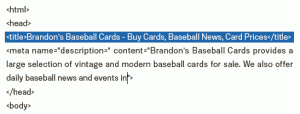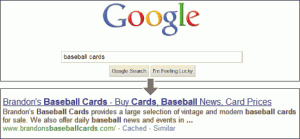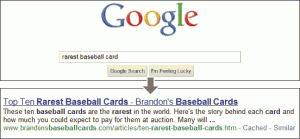Create Unique, Accurate Titles for Every Page
An example may help our explanations, so we’ve created a fictitious website to follow throughout the guide. For each topic, we’ve fleshed out enough information about the site to illustrate the point being covered. Here’s some background information about the site we’ll use:
[fancy_box]Website/business name: “Brandon’s Baseball Cards”
Domain name: brandonsbaseballcards.com
Focus: Online-only baseball card sales, price guides, articles, and news content
Size: Small, ~250 pages[/fancy_box]
Indicate page titles by using title tags

A title tag tells both users and [tippy title=”search engines” reference=”” header=”on”]Computer function that searches data available on the Internet using keywords or other specified terms, or a program containing this function.[/tippy] what the topic of a particular page is. The <title> tag should be placed within the [tippy title=”head tag” reference=”” header=”on”]An element that indicates the header in an HTML document. The content of this element will not be displayed in a browser.[/tippy] of the [tippy title=”HTML” reference=”” header=”on”]Abbreviation for HyperText Markup Language, a language used when describing web page documents. It denotes the basic elements of web pages, including the document text and any hyperlinks and images embedded within.[/tippy] document. Ideally, you should create a unique title for each page on your site.
[divider]
Page title contents are displayed in search results

[clearboth]

[clearboth]

[divider_padding]
Best Practices
[toggle title=”Accurately describe page content” variation=””]
Choose a title that is descriptive and communicates well the main topic of the page content. Do not choose a title without relation to the content on the page or useless titles such as “Untitled” or “Page 7″.
[/toggle]
[toggle title=”Create a unique title tag for each page” variation=””]
Give each page a unique title, helping Google know how it is different from any/all other pages. Do not use a single title tag for all or a group of pages on your site.
[/toggle]
[toggle title=”Use brief, but descriptive titles” variation=””]
Titles should be both short and informative. If the title is too long, Google will show only a portion of it in the search results. Most search engines use a maximum of 60 characters for the title. Avoid stuffing keywords that are unneeded or misleading.
[/toggle]
[divider_padding]
Further Study
If you’re unfamiliar with the different parts of a Google search result, you might want to check out: